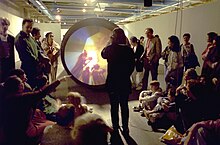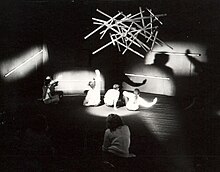
Back Interaktiewe kuns Afrikaans فن تفاعلي Arabic Art interactiu Catalan Interaktive Kunst German Arte interactivo Spanish Interaktiivinen taide Finnish Art interactif French Arte interattiva Italian インタラクティブアート Japanese 인터랙티브 아트 Korean


Interactive art is a form of art that involves the spectator in a way that allows the art to achieve its purpose. Some interactive art installations achieve this by letting the observer walk through, over or around them; others ask the artist or the spectators to become part of the artwork in some way.[2]
Works of this kind of art frequently feature computers, interfaces and sometimes sensors to respond to motion, heat, meteorological changes or other types of input their makers have programmed the works to respond to. Most examples of virtual Internet art and electronic art are highly interactive. Sometimes, visitors are able to navigate through a hypertext environment; some works accept textual or visual input from outside; sometimes an audience can influence the course of a performance or can even participate in it. Some other interactive artworks are considered as immersive as the quality of interaction involve all the spectrum of surrounding stimuli. Virtual reality environments like works by Maurice Benayoun and Jeffrey Shaw are highly interactive as the work the spectators – Maurice Benayoun call them "visitors", Miroslaw Rogala calls them (v)users, Char Davies "immersants" – interact with take all their fields of perception.
Though some of the earliest examples of interactive art have been dated back to the 1920s, most digital art didn't make its official entry into the world of art until the late 1990s.[3] Since this debut, countless museums and venues have been increasingly accommodating digital and interactive art into their productions. This budding genre of art is continuing to grow and evolve in a somewhat rapid manner through internet social sub-culture, as well as through large scale urban installations.
- ^ Chambre à Musique:http://www.ludicart.com/historique/Chambre%20%C3%A0%20Musique%20CCL/Chambre_a_Musique_CCL.html
- ^ Soler-Adillon, Joan (2015-12-21). "The intangible material of interactive art: agency, behavior and emergence". Artnodes (16). doi:10.7238/a.v0i16.2744. ISSN 1695-5951.
- ^ Paul, C: Digital Art, page 67. Thames & Hudson Inc, 2003.
© MMXXIII Rich X Search. We shall prevail. All rights reserved. Rich X Search